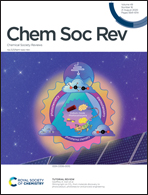Molecular catalysis of CO2 reduction: recent advances and perspectives in electrochemical and light-driven processes with selected Fe, Ni and Co aza macrocyclic and polypyridine complexes
Abstract
Earth-abundant Fe, Ni, and Co aza macrocyclic and polypyridine complexes have been thoroughly investigated for CO2 electrochemical and visible-light-driven reduction. Since the first reports in the 1970s, an enormous body of work has been accumulated regarding the two-electron two-proton reduction of the gas, along with mechanistic and spectroscopic efforts to rationalize the reactivity and establish guidelines for structure–reactivity relationships. The ability to fine tune the ligand structure and the almost unlimited possibilities of designing new complexes have led to highly selective and efficient catalysts. Recent efforts toward developing hybrid systems upon combining molecular catalysts with conductive or semi-conductive materials have converged to high catalytic performances in water solutions, to the inclusion of these catalysts into CO2 electrolyzers and photo-electrochemical devices, and to the discovery of catalytic pathways beyond two electrons. Combined with the continuous mechanistic efforts and new developments for in situ and in operando spectroscopic studies, molecular catalysis of CO2 reduction remains a highly creative approach.

- This article is part of the themed collections: Biohybrid approaches for energy conversion and Earth Abundant Metals in Catalysis


 Please wait while we load your content...
Please wait while we load your content...